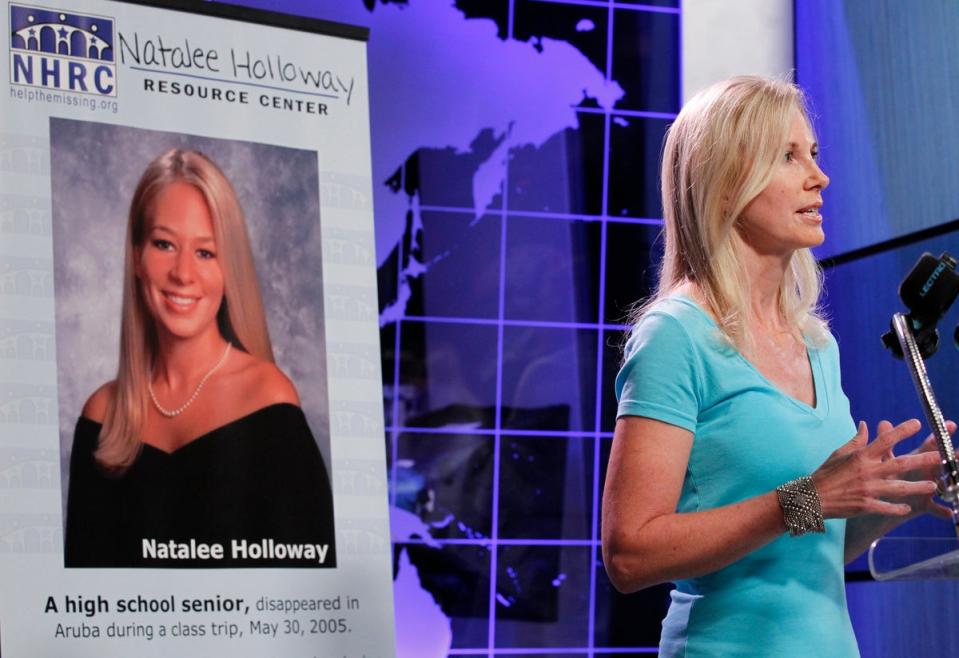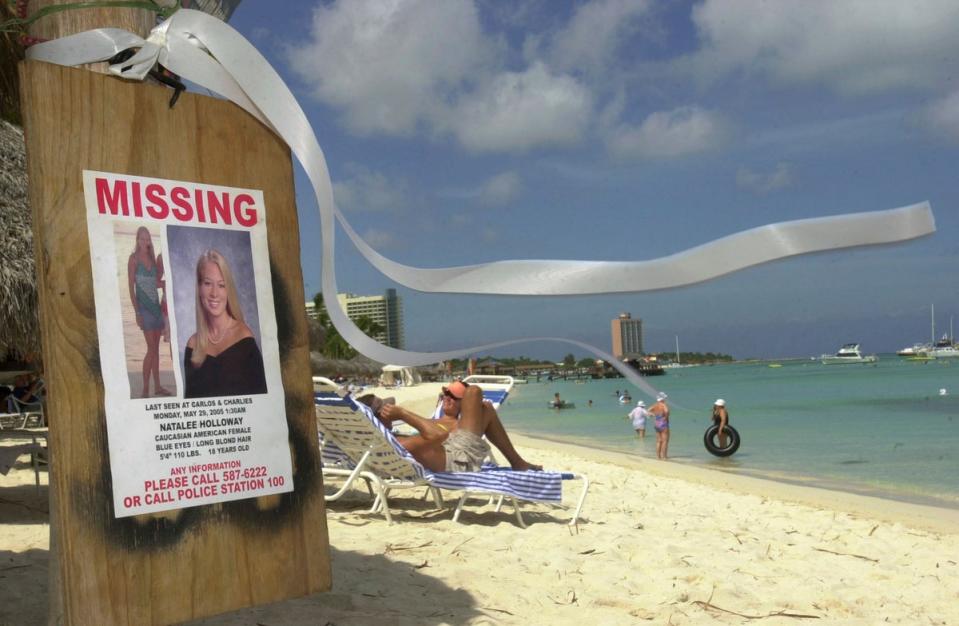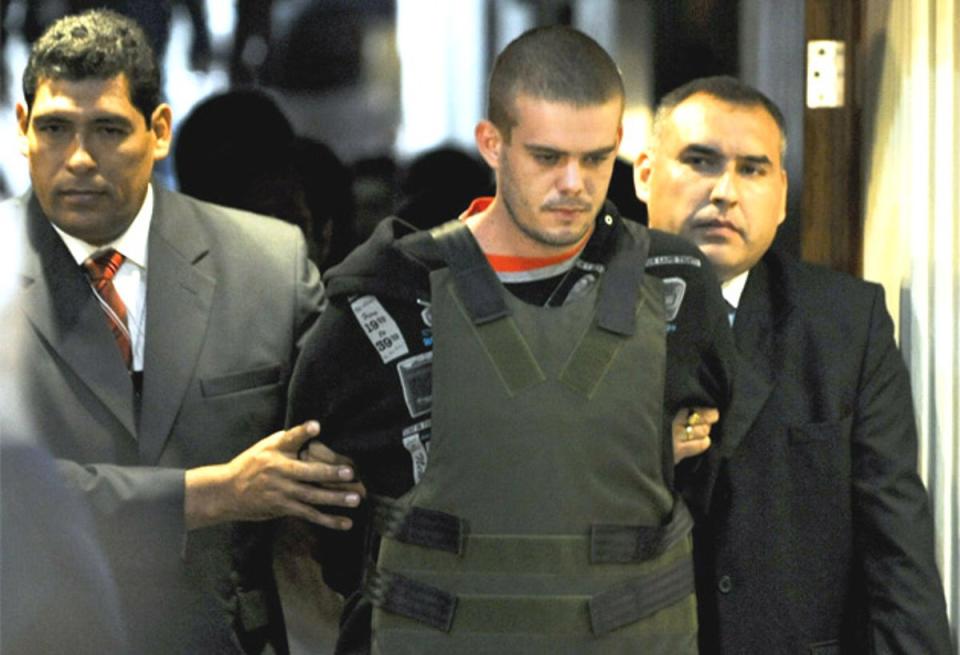Joran van der Sloot killed Natalee Holloway for rejecting him. He’ll never face full American justice
Beth Holloway has spent 18 years trying to find out what happened to her daughter Natalee after the Alabama teen disappeared on her graduation trip to the island of Aruba in May 2005.
Every day, the heartbroken mother kissed her daughter’s senior portrait and wondered if today would be the day she was found. But deep down, she knew Natalee wasn’t coming home.
On 18 October 2023, she finally got the answer that confirmed her worst fears.
Joran van der Sloot, now 36, who has long been considered the chief suspect in her daughter’s disappearance, admitted to bludgeoning Natalee Holloway to death on a beach and dragging her body out into the ocean after she rejected his sexual advances.
The chilling confession was revealed after van der Sloot, who was extradited to Alabama earlier this year, pleaded guilty to federal charges of attempting to extort money from Beth Holloway in 2010 in exchange for information about the location of her daughter’s body.
But Natalee’s remains have never been found and she was declared legally dead in 2012. While van der Sloot remained a suspect in the case, police never found enough evidence to charge him.
The plea agreement included an unusual provision for van der Sloot to “provide all information and evidence” about what happened to Natalee Holloway and to let her family hear him in “real time” give his account to federal investigators.
Beth Holloway said in an interview with The Associated Press that the family made the decision to allow the plea agreement to “finally get the answers we’ve been searching for for all these years.”
“The not knowing is the never-ending nightmare,” she later told NBC News. “And that’s worse.”
Despite confessing to Natalee’s killing, van der Sloot will not be charged in the US for her death.

But to her parents, his confession brought peace and closure to the “never-ending nightmare” that altered their lives forever.
At van der Sloot’s hearing in October, Beth Holloway had a chance to face him.
“You changed the course of our lives and you turned them upside down,” she told the Dutch national. “You are a killer. You have finally admitted that, in fact, you murdered her.”
Natalee’s disappearance became one of the most famous missing person cases of the decade as it dominated headlines and filled evening newscasts, capturing the public’s attention and spurring dozens of bizarre theories over the years. Countless books, movies and podcasts have been made about her case, but there was never an ending. Until now.
Beth Holloway said the confession is justice for Natalee, and that is enough for her.
“After 18 years, Natalee’s case is solved,” Beth Holloway said with a smile shortly after the court hearing ended last week. “It’s over. Joran van der Sloot is no longer a suspect in my daughter’s murder. He is the killer.”
Natalee Holloway, 18, of Mountain Brook, Alabama, went missing during a high school graduation trip to Arub. She was last seen leaving a bar on the night of 30 May 2005 with van der Sloot, a Dutch national who was a student at an international school on the island.
Van der Sloot was questioned following her disappearance, but the evening’s details were never clear, largely complicated by the suspect’s continuously changing stories.
His confession, however, revealed a horrific account of how he brutally killed Natalee after she rejected him.
Van der Sloot explained how they were walking along the beach in Aruba when he laid her down in the sand and they started kissing. When he started to “feel her up,” he said Holloway told him no, but he kept going.
“She tells me she doesn’t want me to feel her up.....Uh, I insist. I keep feeling her up either way,’’ van der Sloot said, according to the transcript. “Uhm, and uh, she knees me uh, she ends up kneeing me in the crotch.”
“When she knees me in the crotch, uh, I get up, uh, on the beach and I kick her extremely hard in the face,” he continued. “She’s laying down unconscious, possibly even dead, but definitely unconscious.”
Van der Sloot said he then smashed her head in with a cinder block he found on the beach.
“I walk up to about my knees into the ocean and I push her into the – into the sea. Uhm, and uhm, yeah, after that I – I get out. I- I walk home.”
The Dutch national was just 17 at the time of the killing. Although he became the prime suspect, no charges stuck and he fled Aruba, cutting a problematic path through his native Holland and then Thailand before ending up in South America.
In 2010, he began contacting the Holloway family taunting them with promises of information about Natalee’s death and the location of her body.

Then on 30 May 2010, five years to the day from Natalee’s disappearance, van der Sloot carried out another brutal murder in a violent rage that eerily echoed Natalee’s case.
Stephany Flores Ramirez, a 21-year-old Peruvian woman, was found dead in van der Sloot’s Lima hotel room after he attacked her during an argument after she learned that he was linked to Natalee’s disappearance.
Stephany, who was a student at the University of Lima and daughter of a prominent businessman, met van der Sloot while playing poker at a casino in Lima. They continued their game of poker online back in his hotel room when a message popped up about Natalee’s case.
The message from an unknown person read, “I’m going to kill you, you little Mongoloid.”
When he explained to Stephany about his alarming connection to Natalee’s disappearance, he said in a confession that she “struck me on the left side of my head with her fist.”
Van der Sloot said that he “impulsively hit her in the face” and saw blood.
“It affected me so much that I took her by the neck with both hands and I strangled her for a minute,” he said.
“At that moment I thought, ‘What am I doing?’ I got up thinking, ‘What can I do now?’ and I also had blood on my shirt. There was also blood on the bed so I took my shirt, placed it on her face pressing hard until I killed Stephany.”
He added that he’d “lost control of my actions, I didn’t know what I was doing. I remember what I was doing but not the motive. It was an impulsive act after receiving a blow to the head.”

In January 2012, van der Sloot was sentenced to 28 years in prison for Stephany’s murder. The same year, Natalee Holloway was officially declared dead.
He is currently serving 28 years in a Peruvian prison for Stephany’s murder and is set to return to Peru following last week’s hearing.
At the hearing, van der Sloot pleaded guilty to one count each of extortion and wire fraud in exchange for a 20-year sentence. That prison term will run concurrently with the 28-year sentence.
US Judge Anna Manasco said the details of his confession factored into her sentencing decision.
“You have brutally murdered — in separate instances years apart — two young women who refused your sexual advances,” she said.
Van der Sloot is set to be released in 2043, but if he is freed early, he will serve the rest of a 20-year sentence for extorting Beth Holloway in the US.
However, authorities in Aruba have requested documents from the US Department of Justice in the extortion case against van der Sloot, including his description of killing Natalee.
“We have requested the US Department of Justice for the court documents, transcripts and all the documents related to the investigation,” Ann Angela, a spokeswoman for the prosecutor’s office in Aruba, wrote in an email, according to The Associated Press.
She said they will, “review and analyze them before deciding on the procedural steps to be taken against Joran van der Sloot.”
“The disappearance of Natalee Holloway is still an open investigation in Aruba,” she added.
An attorney for Holloway’s father said last week it was his understanding, based on conversations with authorities, that the statute of limitations for murder has expired in Aruba.
The US does not have jurisdiction to prosecute him for the crime that happened in Aruba, the Associated Press reported.
Van der Sloot was shackled and wore an orange jail uniform when he addressed the court at his hearing on the extortion charges in Alabama on 18 October.
“I would like to take this chance to apologise to the Holloway family, to apologise to my own family,” he said, adding that he is now a Christian. “I am no longer that person I was back then.”
Dave Holloway, Natalee’s father, called van der Sloot “evil personified.” He said that after witnessing the admission, he believes van der Sloot alone killed his daughter but questioned if others helped conceal the crime.
“While I am satisfied that the defendant murdered Natalee alone, I have no doubt others provided him with aid and assistance in preventing us from being able to return Natalee home,” Dave Holloway said.
“While it may not be in a court of law, I believe their judgment is still to come," Dave Holloway said. “We are living every parent’s nightmare. Today and every day, please hug your children in honor and loving memory of our daughter, Natalee Ann Holloway.”
Van der Sloot’s guilty plea took place in an Alabama courtroom, just a few miles from where Natalee attended high school, and three days before what would have been her 37th birthday.

“Natalee will be 18 forever in my heart,” her mother, Beth Holloway, wrote in her federal court victim impact statement.
Van der Sloot’s story has been linked inextricably to her daughter’s for the entirety of the past 18 years.
When the two teenagers met in Aruba, their lives had not been too dissimilar. Both were honours students, Natalee due to attend the University of Alabama in the fall on a full scholarship and van der Sloot planning to attend a college in Florida.
Natalee was in Aruba with fellow graduating classmates from Mountain Brook, a swanky Birmingham suburb, while the Dutch tennis player was scheduled to receive his diploma within days from the International School of Aruba.
His mother, Anita, was a teacher at the school, while his father, Paulus, worked for the justice department and was training to be a judge. The family had moved to Aruba when van der Sloot was a boy, and he grew up on the island with his two brothers, building a reputation as a star tennis player and playing doubles matches with his father.
As van der Sloot progressed through his teens, however, his mother would later admit that he was sneaking out to gamble and suffering suspected psychiatric problems. It was at a casino, it seems, where he first made contact with the group of Alabama graduates; he’d been playing at the Holiday Inn, where they were staying.
Before van der Sloot’s confession, it was only known that the pair socialised together at a Carlos n’ Charlie’s on 30 May 2005 – a well-known island party establishment – and at one point left, after which the Alabama teen was in the company of van der Sloot and two of his friends, brothers Deepak and Satish Kalpoe.
The trio alternately claimed, over the years, that they’d dropped Natalie at the hotel, that they’d left her at the beach, that van der Sloot had sex with her, that he didn’t, that she’d suffered some kind of seizure.
During the initial investigation, the Holloways were appearing on TV screens in living rooms across America; Nancy Grace, whose show had debuted on CNN just three months before Natalee’s disappearance, seized upon the story.

In Aruba, the Holloways were putting pressure on Aruban authorities and generally maintaining a powerfully visible presence with an entourage; tensions smouldered. Ultimately, without a body or any conclusive evidence, van Der Sloot and his friends were let go.
The Dutchman returned to his home country with his father, ostensibly with plans to attend college, but the cloud of suspicion hanging over him had followed him to the Netherlands. He was particularly hounded by a Dutch crime journalist, Peter de Vries, who used hidden cameras and undercover operatives to ostensibly get Van Der Sloot to make what appeared to be some types of confessions.
In February 2008, a record-breaking 7 million people – nearly half the population of Holland at the time – tuned in to watch van der Sloot and de Vries on a Dutch late-night show; hordes soon descended on an apartment, wrongly rumoured to be van der Sloot’s home in a town in the north of the country.
Later that year, van der Sloot moved to Thailand, where he bought a restaurant and where de Vries continued to raise questions about the Dutchman’s alleged misdeeds, particularly his dealings with women. It wasn’t long before the suspect left Southeast Asia for South America.
By 2010, he was in Peru, continuing to indulge his passion for gambling – and met 21-year-old Stephany Flores Ramirez playing poker at a Lima casino.
From a prominent and well-connected family, she was a business administration student at the University of Lima and ran the merchandising arm of the family entertainment and event-promotion business, her brother said at the time.
On the same night she met van der Sloot, casino video showed Stephany cashing in chips for $10,000, her father said.
Then she and the Dutchman left – and Stephany’s beaten body was found hours later in van der Sloot’s hotel room after he’d checked out without returning his key.
He was subsequently arrested in Chile and extradited back to Peru, laying bare a chilling version of events that led to Stephany’s death in a confession.
“We went to my room and played poker on my laptop, and at that time I opened my email and saw a message saying, ‘I’m going to kill you, you little Mongoloid,’ referring to the ‘Holoway (sic) case’ ...,” he told Peruvian police through a Dutch translator.
Van der Sloot pleaded guilty to killing her.
According to van der Sloot, when he told Stephany about his alarming connection to the disappearance, she “struck me on the left side of my head with her fist.”
He then elbowed her in the nose and strangled her to death.
He said that he’d “lost control of my actions, I didn’t know what I was doing. I remember what I was doing but not the motive. It was an impulsive act after receiving a blow to the head.”
Stephany’s brother Enrique Flores talked to CNN in the days after her murder, recalling how trusting she was.
“My sister is very friendly ... always smiling, always nice to everyone,” he said at the time. "I think about how she felt with him, that she probably did not think ... and it is ... so hard to think about that."
“My sister was the only girl in our house, the queen of our family,” he added. “What she wanted, she got.”
Mr Flores talked about how his sister loved to play soccer and would organize matches with her friends in the family’s backyard.
“She had a lot of friends, a lot of people are crying,” he said at the time.
In January 2012, van Der Sloot was sentenced to 28 years in prison for Stephany’s murder. The same year, Natalee Holloway was officially declared dead.
By then, however, the Dutchman was already in legal trouble in her home state.

On 3 June 2010 – four days after Stephany’s murder and the anniversary of Natalee’s disappearance – federal prosecutors in Birmingham announced a criminal complaint against Van der Sloot “on wire fraud and extortion charges in connection with his soliciting money in May on promises he would reveal the location of Natalee Holloway’s remains in Aruba and circumstances of har death.”
The complaint charged that the suspect “extorted $15,000 from an individual as partial payment toward his promise to reveal the location of Natalee Holloway’s remains for $250,000 ... the complaint also charges Van der Sloot with wire fraud for causing the $15,000 to be transferred by wire from a Birmingham bank to a bank in the Netherlands in furtherance of his scheme to defraud.”
The target of the alleged scheme – a woman tragically re-victimised – was Beth Holloway, who made a $25,000 down payment only for the information to prove to be false.
According to AP, “an FBI agent wrote in an affidavit that van der Sloot reached out to Holloway’s mother and wanted to be paid $25,000 to disclose the location and then another $225,000 when the remains were recovered. Van der Sloot requested that an agreement be drafted and signed by the mother and him.
“A New York attorney representing Beth Holloway traveled to Aruba with the agreement and gave van der Sloot $10,000 in cash during a recorded meeting, according to court records,” AP reported. “The indictment says both men then went to a site where the student’s remains were purportedly buried, and Beth Holloway made a wire transfer for $15,000 to van der Sloot’s bank account in the Netherlands.
“In the affidavit, the FBI agent wrote that van der Sloot in later emails to the attorney admitted to lying about the location.”

In January, he was given an additional 18 years in prison for drug smuggling, according to the Telegraaf, allegedly playing a “crucial role” in selling cocaine inside and even sending it to recipients outside Peru.
The convicted murderer has certainly been busy while behind bars in South America; in July 2014, he married a 25-year-old Peruvian woman, Leidy Figueroa Uceda, who gave birth to his child that autumn.
“Many people judge Joran and criticise him saying he is a monster and an assassin, but when you get to know him, you know he is different,” his wife told MailOnline that year. Describing the prisoner as “gentle, sensitive” and “kind,” she also said she did not believe he’d killed Natalee – but didn’t want to ask.
Despite the marriage and new baby, the couple would be barred from enjoying life together on the outside until at least 2045 – and that was before the announcement of his extradition, made possible by a 2001 treaty between Peru and the US.
On Monday, he remained at an Alabama jail where he has been held during the proceedings in the United States.
Beth Holloway said in an interview with The Associated Press that it felt “victorious” to see van der Sloot in court and “finally be at the end of this nightmare.”
“I’m the mother, and I wanted answers as to what happened to Natalee,” she added. “That’s what I had been searching for for 18 years.”


